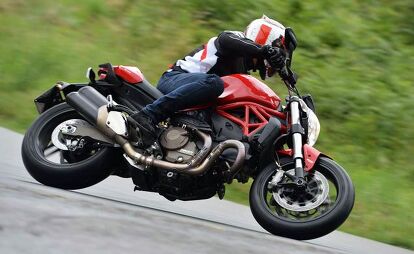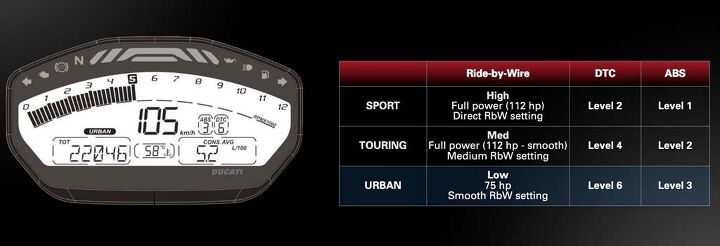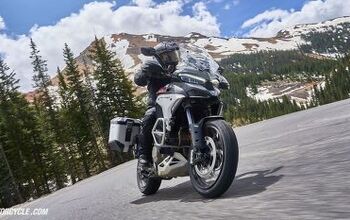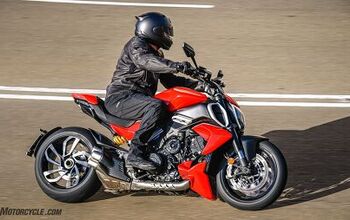2015 Ducati Monster 821 Review - First Ride
Lesser displacement and price, but is it a better value?
Since the launch of Ducati’s Monster 1200 S ($15,995) earlier this year, we’ve extensively tested the bike on both the track and the street. What we found is that while the 1200 S is not the best choice for a naked track-day weapon, it is a consummate roadster when set between the yellow and white lines. Now comes the Monster 821 with an MSRP of $11,495. Is the smaller-displacement Ducati Monster a better choice than the base-model Monster 1200 at $13,495?
2015 Ducati Monster 821
| Engine | 18.75/20 |
| Suspension/Handling | 12.5/15 |
| Transmission/Clutch | 8.5/10 |
| Brakes | 8.0/10 |
| Instruments/Controls | 3.5/5 |
| Ergonomics/Comfort | 7.0/10 |
| Appearance/Quality | 8.0/10 |
| Desirability | 8.0/10 |
| Value | 6.5/10 |
| Overall Score | 80.75/100 |
Not if you like torque. While the standard 1200 Monster gives up only five ft-lbs to the S model, the 821cc Testastretta 11° engine is down 21 ft-lb to its 377cc-bigger brother. There’s also 23 less horsepower to play with, but neither figure is surprising given the displacement difference. In fact, the 821cc powerplant is very flexible, exhibiting the ability to spin-up quickly while maintaining a usable flow of torque at any engine speed.
The most observable annoyance of the smaller engine wasn’t its performance but the amount of heat it throws off, most notably on the right side due to exhaust plumbing. The engine’s heat managed to be uncomfortably noticeable even on our cool, rainy day ride.
The electronic connection between twist grip and throttle body feels as natural as a cable-operated system (we’ve repeatedly commended Ducati’s RbW in many of our reviews). The rainy day in the hills surrounding Bologna providing ample opportunity for precise throttle application. Choosing the Touring riding mode, which delivers all the engine’s power with electronically engineered smoothness, DTC at level 4 and ABS at level 2, I managed only two unintended slides on the wet Italian tarmac. Switching riding modes can be done on the fly, and when the sun dried the roads for the afternoon portion of our test, I chose the Sport setting and enjoyed the direct connection between twist and go.
Beyond the obvious engine performance and instrument cluster differences, in what other ways does the 821 differ from the 1200? Well, not many. The 821’s fork is non-adjustable, it has a slightly higher compression ratio (12.8:1 vs 12.5:1), weighs eight claimed wet pounds less (453 lbs vs 461 lbs), and rolls on a new size 180/60-17 Pirelli Diablo Rosso II rear tire. There’s some internal gear ratio differences, and the 821 has a larger rear sprocket (46 vs 41) for shorter overall gearing, but that’s about it.
Probably the most significant difference affecting agility is the 821’s 1.2-inch-shorter wheelbase. The 821’s eight-pound weight advantage certainly helps, but the increased flickability of the smaller Monster is certainly a result of the reduced space between contact patches and the new size of Pirelli’s rear tire. Combined with the minimal trellis steel frame, adequately damped suspension and wide superbike-style bars, a rider can choose a line then change his mind mid-corner without any complaint from the bike.
Braking components are same between the 821 and 1200 with Brembo M4-32 calipers gripping dual 320mm discs up front and a single, twin-piston caliper and 245mm disc out back. Front braking power is both progressive and substantial, while rear braking forces require a hardy stomp on its pedal.
Seating position is comfortably sporty, but another carryover from the 1200 Monster is the footpeg bracketry that pushes the rider’s ankle outward in an awkward position when the going gets fast and you’re on the balls of your feet. While not a deal breaker on the street, we found the minor inconvenience became a liability at the track when testing the 1200 S.
Like the Monster 1200, the 821 is an excellent road bike – arguably better than the 796 it’s replacing – with all the Italian persona a person can ask for in a naked. Ducati’s propaganda positions (to some degree) the Monster 821 as a bike for beginners and women. We believe the Monster 696 at $9,295 with a slightly lower seat height (30.3 vs 30.9 inches) and substantially less wet weight (407 vs 453 lbs) to be the better choice in that regard.
Which begs the question, is the 821 a better value than the 1200 for the experienced enthusiast? As good as the 821 is, for only $2k you get more performance from a sexier machine. If you’re concerned about power, ride the 1200 around in its Urban ride mode that limits hp to 100 and jacks up TC and ABS. Once comfortable with the bike, choose the Touring mode and get more performance without having to spend more money.
However, two grand is two grand, and that can buy a lot of riding gear, insurance coverage, etc. So, if you choose to go the 821 route, you’ll still be purchasing a naked bike that’ll keep you happy for years to come. And, when presented a future opportunity to pass a slower rider on a larger-displacement Monster, this is oftentimes all the reward and justification one needs for saving the money and buying the smaller bike.
+ Highs
- More affordable than Monster 1200
- Nimble handling
- Excellent engine performance
– Sighs
- Only $2k less than Monster 1200
- Excessive engine heat
- Attractive but useless rear fender
A former Motorcycle.com staffer who has gone on to greener pastures, Tom Roderick still can't get the motorcycle bug out of his system. And honestly, we still miss having him around. Tom is now a regular freelance writer and tester for Motorcycle.com when his schedule allows, and his experience, riding ability, writing talent, and quick wit are still a joy to have – even if we don't get to experience it as much as we used to.
More by Tom Roderick














































Comments
Join the conversation
I own a 1200, and have to wonder if the author has ridden a 1200, "excessive heat" for the 821??? The 1200 is terrible. It make me wonder about his credibility. Regardless, I'm very happy with it.
Damn! I was really looking forward to this but that excessive heat issue definitely puts me off. I use my bikes to commute and splitting slowly will be a nightmare in summer. Too bad. I really enjoyed that 821 engine when I road the Hyperstrada. Maybe I should just buy that.